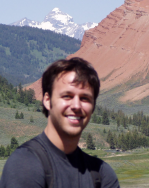Research Highlight
The Ecology of Organizations in Greater Yellowstone
 This Research Highlight was written by Center graduate student David Cherney. David is a doctoral student at the University of Colorado at Boulder and a research associate with the Northern Rockies Conservation Cooperative in Jackson, WY. He holds a master’s degree in environmental management from Yale University and a bachelor’s degree in the environment, economics, and politics from Claremont McKenna College. David has conducted research on natural resource policy and management in California, New England, Ecuador, and greater Yellowstone. His dissertation work focuses on strategies to manage persistent policy conflict in greater Yellowstone.
This Research Highlight was written by Center graduate student David Cherney. David is a doctoral student at the University of Colorado at Boulder and a research associate with the Northern Rockies Conservation Cooperative in Jackson, WY. He holds a master’s degree in environmental management from Yale University and a bachelor’s degree in the environment, economics, and politics from Claremont McKenna College. David has conducted research on natural resource policy and management in California, New England, Ecuador, and greater Yellowstone. His dissertation work focuses on strategies to manage persistent policy conflict in greater Yellowstone.
This research highlight focuses on a collaborative research project David is working on with Garry Brewer and Susan Clark of Yale University, Lydia Dixon and Jason Wilmot of the Northern Rockies Conservation Cooperative, and Jonathan Schechter of the Charture Institute. For more information please contact david.cherney@colorado.edu.
 Yellowstone National Park – the world’s first national park – was established in 1872 as an innovative tool to protect the unique landscape and wildlife in the Northern Rockies. As ecological knowledge of the Yellowstone system developed, conservation leaders suggested that protection of the 2.2 million acres within Yellowstone’s borders was a necessary but insufficient means to achieve regional conservation goals. Today the Yellowstone region is often referred to as ‘greater Yellowstone.’ Greater Yellowstone is a complex array of more than 20 million acres of private and public land including two national parks (Yellowstone and Grand-Teton), three national wildlife refuges, and seven national forests. This system is often hailed as one of the last intact ecosystems in the United States, serving as a global model for conservation.
Yellowstone National Park – the world’s first national park – was established in 1872 as an innovative tool to protect the unique landscape and wildlife in the Northern Rockies. As ecological knowledge of the Yellowstone system developed, conservation leaders suggested that protection of the 2.2 million acres within Yellowstone’s borders was a necessary but insufficient means to achieve regional conservation goals. Today the Yellowstone region is often referred to as ‘greater Yellowstone.’ Greater Yellowstone is a complex array of more than 20 million acres of private and public land including two national parks (Yellowstone and Grand-Teton), three national wildlife refuges, and seven national forests. This system is often hailed as one of the last intact ecosystems in the United States, serving as a global model for conservation.
Not long after the formation of Yellowstone, the first non-governmental organization (NGO) to operate in Yellowstone was founded. The Boone and Crocket Club was established in 1887 by Theodore Roosevelt as a means to eliminate the unregulated killing of wildlife in North America, including unregulated take within Yellowstone’s boundaries. The role of a number of NGOs, such as the Boone and Crocket Club, have played in the development of greater Yellowstone is well documented. In contrast, little attention has been paid to the progression of growth within the non-governmental conservation community. We are interested in how a non-governmental community matures.
As a precursor to our project, we informally canvassed conservation leaders in Yellowstone to ask: ‘How many NGOs work within Greater Yellowstone?’ The answer we received from these leaders was “30 to 40 organizations;” a substantial amount of non-governmental activity. However, when we systematically documented the number of organizations in the region we were astonished to find more than 200 conservation NGOs currently operate in greater Yellowstone. Even more stunning was the amount of resources leveraged by these organizations. Our preliminary data suggests that these 200 organizations spend at least $150 million per year.
Our research is centered on the question, “How can conservation organizations more effectively secure their desired outcomes?” The initial phase of our project can consists of two tasks. (1) We are developing a ‘natural history’ of greater Yellowstone’s conservation NGOs. Questions include: Are there patterns in the creation or dissolution of organizations? On which topical issues do they focus? Why functional types of organizations – advocacy, enforcement, land-trusts, etc – exist? How are resources spent? (2) We are conducting a ‘network analysis.’ Questions include: Which organization work with each other? On which issues? Which organizations compete with each other? Which activities appear to complement or detract from each other?
Our project is designed to move beyond what we learn and have an explicit practical component. In the spring of 2008, we plan to hold the first annual Greater Yellowstone Conservation Summit. The workshop will assemble a diverse group of non-profit leaders, experienced professionals, and donors to discuss our current understanding of the greater Yellowstone conservation community. The purpose is to stimulate dialog on the direction of the conservation community and identify opportunities for improved effectiveness.
David Cherney
david.cherney@colorado.edu

